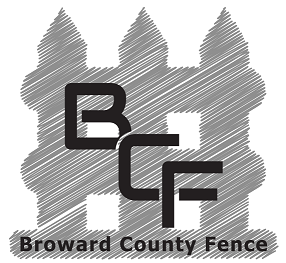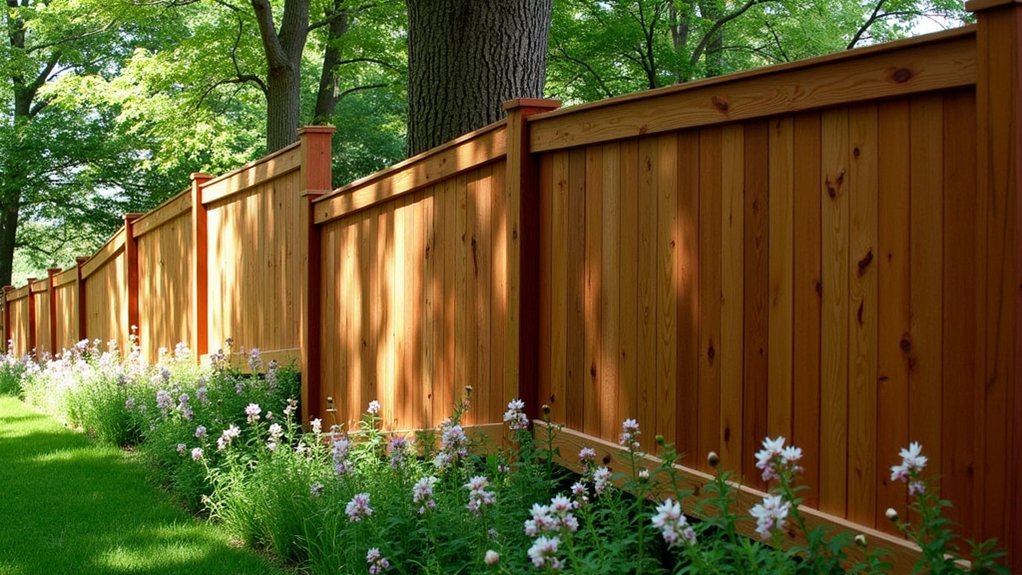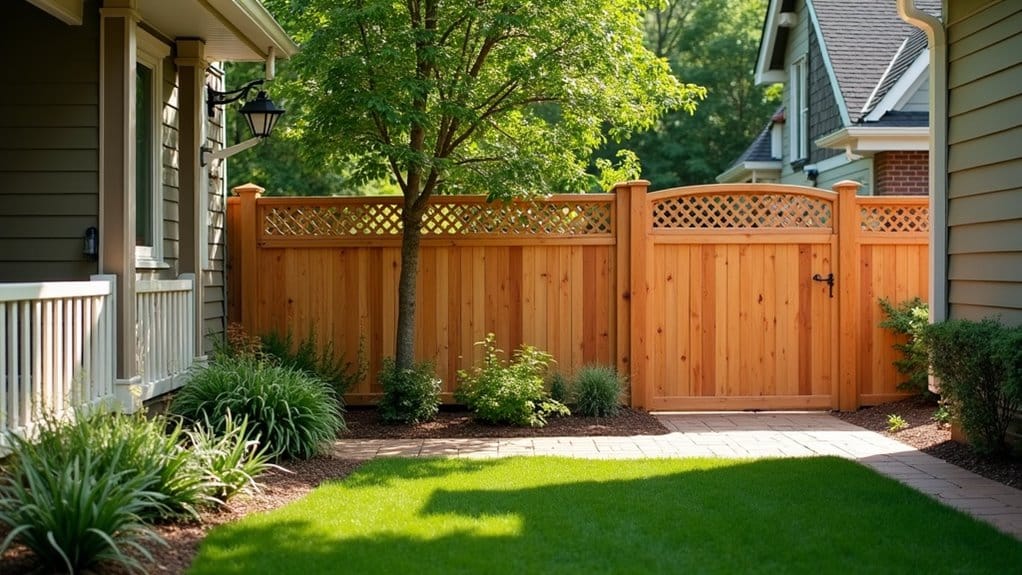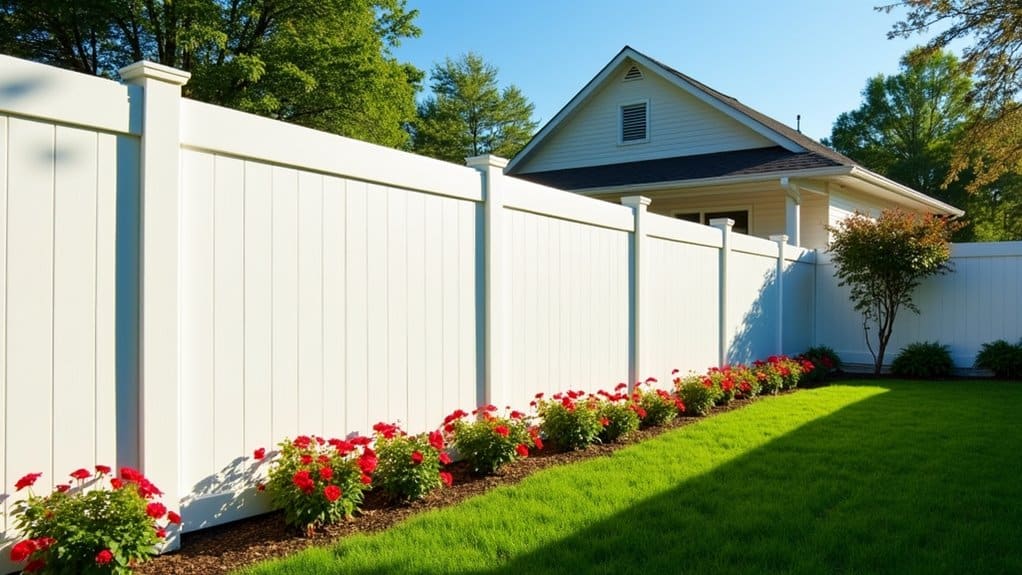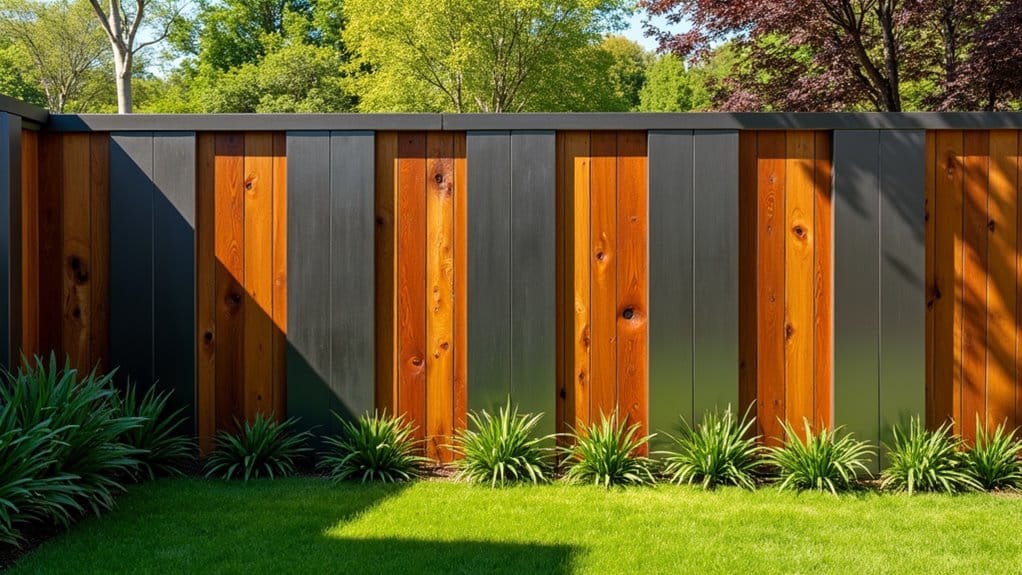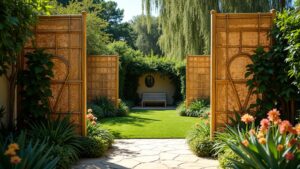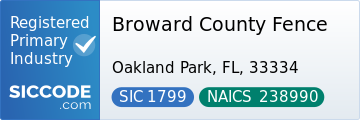When installing custom fencing on sloped or uneven terrain, start by assessing the slope and soil conditions. Use durable materials that can handle weather and erosion, and choose a design that matches your home’s style. Techniques like stepped or racked fencing enhance stability. If needed, budget for professional installation and consider ongoing maintenance and drainage solutions. There are plenty of options to boost both durability and aesthetics in tricky landscapes.
Key Takeaways
- Evaluate the slope and soil type to choose the right materials and installation methods for strength and longevity.
- Use stepped or racked installation to fit the uneven ground while ensuring good drainage and visual appeal.
- Check local regulations for fence height, materials, and necessary permits before starting your project.
- Perform maintenance twice a year to check for post stability and erosion to keep your fence in good shape.
- Install drainage solutions like channel drains or retaining walls to handle water runoff and prevent soil erosion.
Understanding the Terrain

Installing a fence on sloped terrain can be tricky. The landscape presents challenges like steep areas and water runoff that can affect your installation. Erosion control is crucial, as soil erosion can weaken fence posts. You’ll need to carefully evaluate rocky or uneven ground, which makes digging post holes difficult. Additionally, using a retaining wall can help manage soil on uneven terrain, providing extra stability for the fence. Assessing soil conditions is essential to ensure that the materials chosen for your fence can withstand the specific challenges posed by the terrain. Also, gaps at the bottom of fence panels can pose security risks. By assessing the terrain, you can create a fencing solution that tackles these issues while also looking good and lasting longer against the elements.
Importance of Material Selection
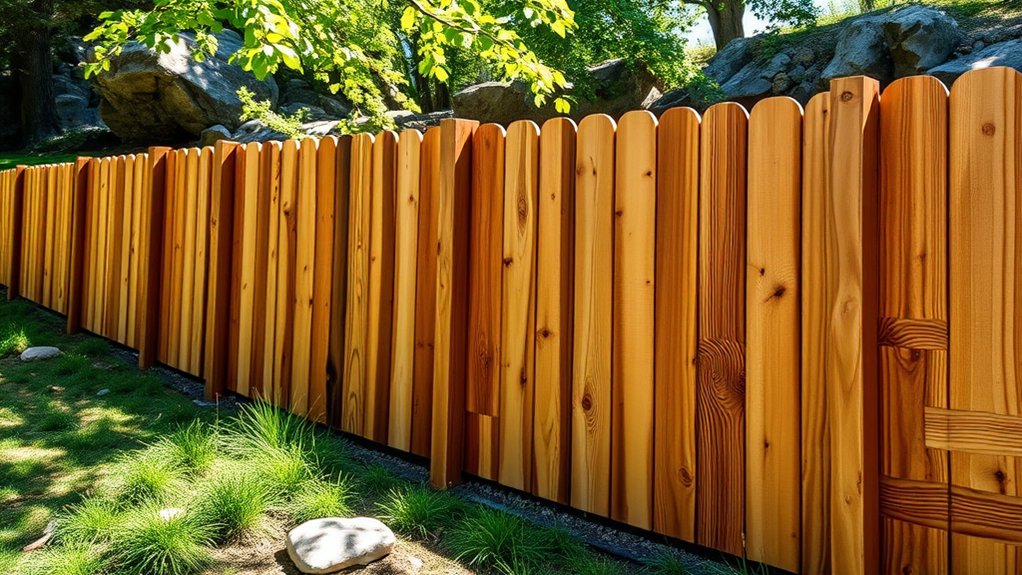
Choosing the right materials for your fence is crucial, especially on sloped land. The materials impact not just strength but also how the fence looks. Here are some key points to consider:
- Local Building Codes: Make sure your fence meets local regulations to avoid fines and ensure safety.
- Durability: Pick materials that can resist weather conditions in your area, like vinyl or treated wood. Racked and stepped methods enhance both function and aesthetics, making material choice even more significant on uneven terrain.
- Maintenance Needs: Think about how much upkeep you’re willing to do. Some materials require more care than others.
- Style Flexibility: Select materials that match your home’s design, like a classic wood fence for a traditional look.
Budgeting for Custom Fencing
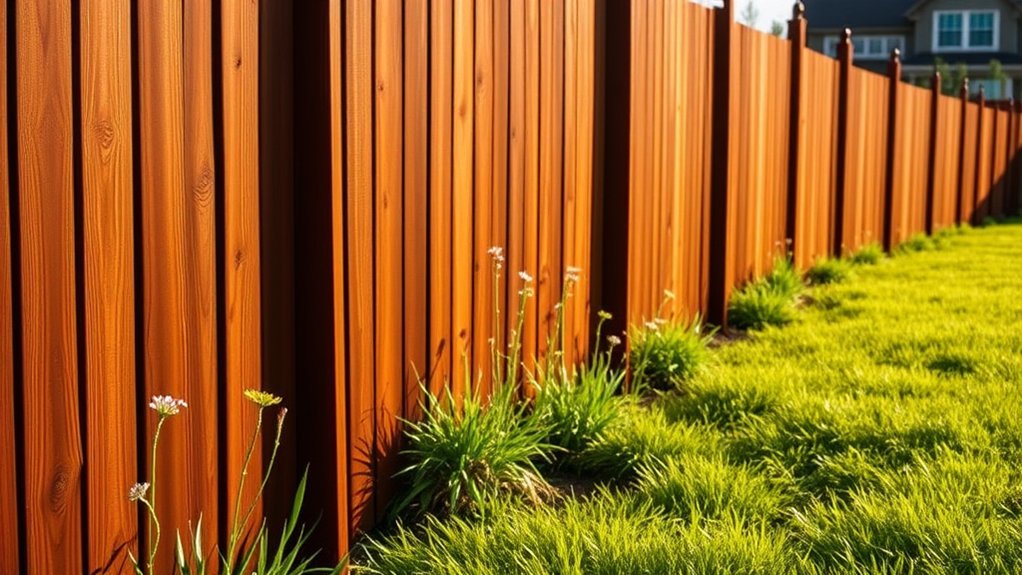
When budgeting for custom fencing on sloped terrain, consider several key cost factors. Material prices can vary significantly based on the type and quality you choose. For example, wood may be cheaper than vinyl, but it requires more maintenance. Fence installation costs can also be influenced by installation methods—more complex designs or challenging landscapes will drive up labor expenses. Additionally, the cost of long-term maintenance should be factored in, as certain materials may incur higher upkeep costs over time. To avoid surprises, it’s crucial to plan ahead.
Cost Factors Overview
When budgeting for custom fencing on sloped land, be aware of these important cost factors:
- Higher Labor Costs: Working on a slope requires skilled labor, which can lead to increased expenses.
- Soil Conditions: If the soil is rocky or unstable, it can complicate installation and slow down the process.
- Complex Installation: Custom adjustments for slope and precise post placement can add to the overall cost.
- Site Preparation: Grading the slope for safe installation can significantly raise your expenses. Additionally, zoning regulations may dictate specific requirements for fence height and type that could impact your budget.
Keeping these factors in mind will help you create a more accurate budget.
Material Price Variability
Understanding material price variability for custom fencing on sloped terrain is key for budgeting. Prices can change based on sourcing and market trends.
For example, wood fencing costs between $9 and $22 per linear foot, while vinyl ranges from $15 to $30. Metal options, like wrought iron, can go as high as $44 per linear foot.
Complex designs may require custom cuts, increasing waste and costs. Local availability and seasonal changes can also affect pricing.
When planning, consider long-term maintenance; vinyl and metal might have higher initial costs but often need less upkeep, impacting your budget over time.
Keep these factors in mind for a solid financial plan.
Installation Method Expenses
When installing custom fencing on sloped land, expect higher costs due to the specialized techniques needed.
Here are some key expenses to consider:
- Skilled Labor: You’ll pay more for experienced workers who can handle sloped installations.
- Site Preparation: Grading and clearing obstacles will increase your upfront costs.
- Specialized Techniques: Methods like terracing or stepped fencing require more time and expertise, raising labor costs.
- Material Waste: Custom cuts for uneven shapes can lead to extra material expenses.
Navigating Local Regulations

Before installing custom fencing on sloped land, check local regulations first.
Review zoning laws for height limits, materials, and property boundaries. Determine if you need permits; you may need to provide detailed plans.
Also, consider environmental rules if your project affects wildlife or water sources. Look into neighborhood covenants for style or height restrictions, and if you’re in a historic district, follow guidelines to preserve the area’s character.
Staying compliant can save you time, money, and headaches later on.
Designing for Aesthetic Appeal
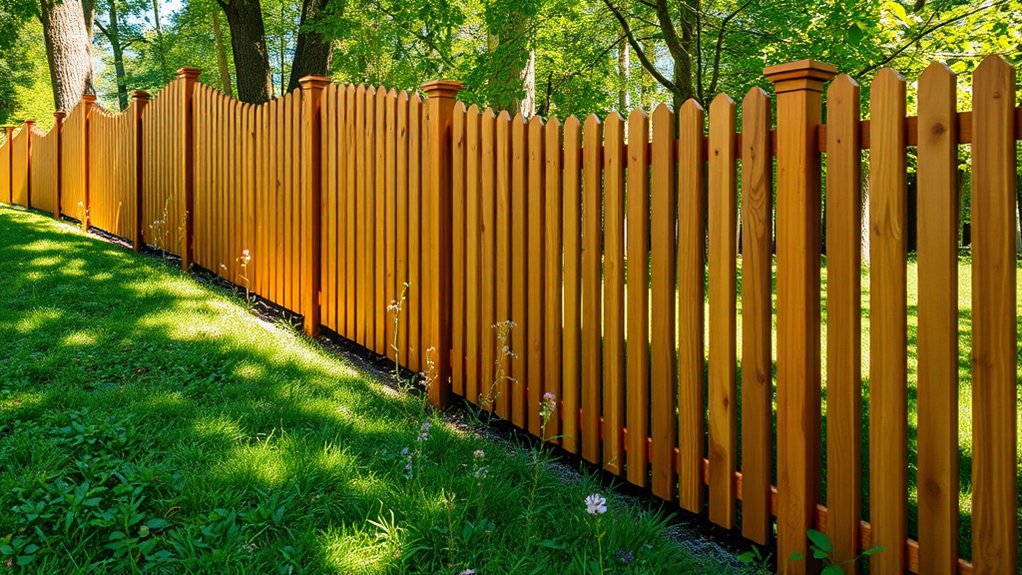
When designing a fence for sloped terrain, aim for both functionality and visual appeal.
Here are some key elements to consider:
- Material Selection: Use durable materials like wood or vinyl that match your home’s style.
- Decorative Accents: Enhance your fence with caps or custom inserts for added flair.
- Landscaping Integration: Plant shrubs or flowers around the fence to soften its appearance.
- Contour Adaptation: Make sure the fence follows the slope to create a cohesive look.
Stepped Fencing Techniques
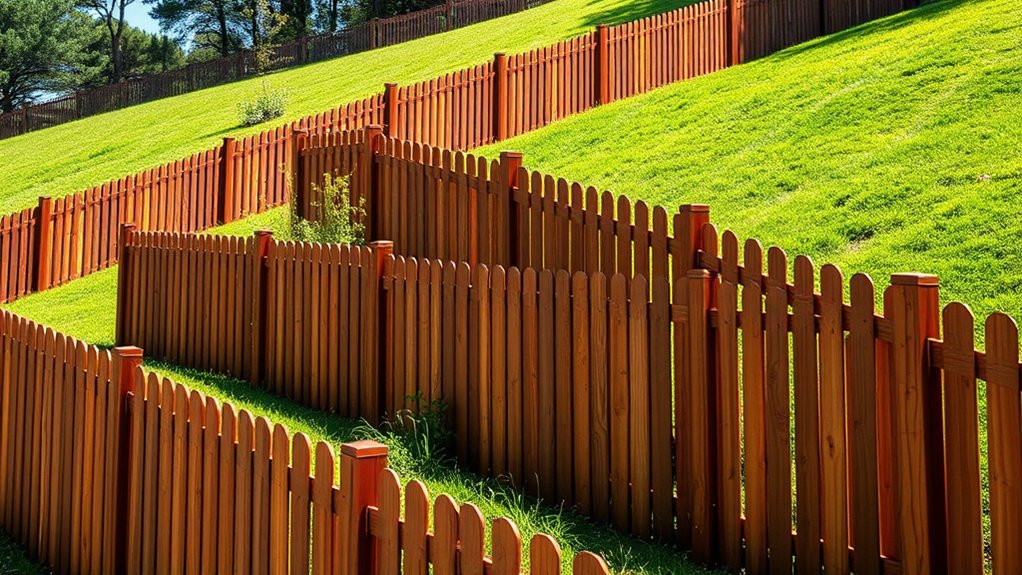
Stepped fencing techniques are ideal for sloped terrains, keeping your fence attractive and sturdy. This method uses horizontal panels that create a neat stair-step look.
Benefits include consistent security and the ability to adjust panel heights easily. However, it can be challenging on steep slopes and requires good drainage to prevent erosion.
To install, start by marking your boundaries and adjusting the post heights for stability. Make sure to set your posts deep and use weather-resistant materials to ensure durability and enhance your property’s appearance.
Racked Fencing Methods
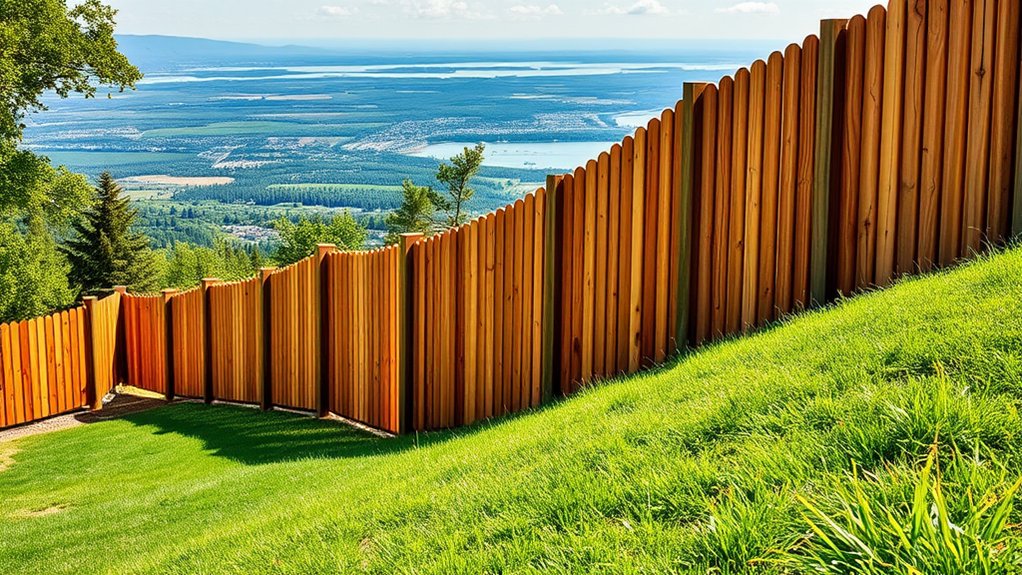
When fencing on sloped terrain, racked fencing is an effective choice. This method allows the fence panels to stay level while the rails adjust to the slope.
Here are the key benefits:
- Creates a visually appealing line in your landscape.
- Offers durability with low maintenance.
- Adapts well to different materials and installation methods.
- Provides a cost-effective solution for your property.
However, be mindful of challenges like needing precise measurements and potential material limitations.
Racked fencing works best on moderate slopes, so careful planning is essential for a successful installation that fits your terrain.
Overcoming Terrain Challenges
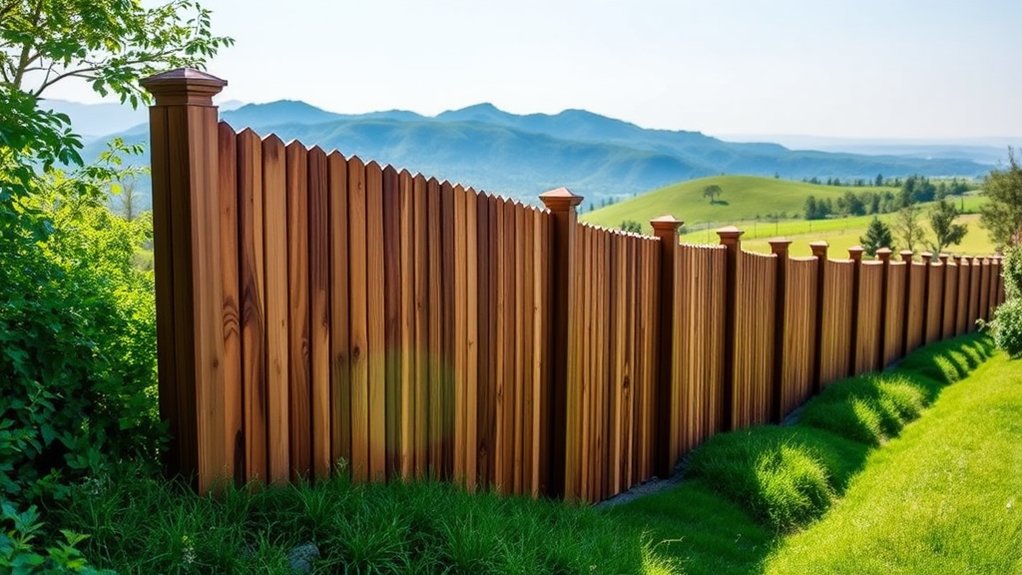
When dealing with sloped terrain, start by assessing the land’s grade and contours. This will help you select the right fencing installation methods that ensure both durability and a good look.
For example, if your yard has a steep slope, consider using a stepped or contoured fence design. These approaches not only improve the fence’s effectiveness but also help it blend in with your landscape.
Terrain Assessment Techniques
To successfully install fencing on sloped terrain, start with a thorough terrain assessment.
Here are four essential techniques:
- Slope Evaluation: Measure the incline to determine the best materials and installation approach.
- Uneven Ground Mapping: Look for bumps and dips that could compromise the fence’s stability.
- Soil Condition Analysis: Assess the soil type to choose the right tools and materials for installation.
- Natural Obstacles Mapping: Identify cliffs or water bodies that could affect fence placement.
Effective Installation Methods
When installing a fence on sloped terrain, it’s essential to choose the right method to ensure stability and aesthetic appeal.
For moderate to steep slopes, a stepped installation is effective. This method involves setting each post at the slope’s height, resulting in level sections that maintain a consistent line.
On the other hand, racked installations follow the slope’s natural contour, which works best for gentle inclines, preventing gaps under the panels.
If you’re dealing with varying terrain, a hybrid approach can combine both methods for the best results.
Planning your layout carefully is crucial for making consistent adjustments, and precise cutting and fitting of the panels ensure a durable and attractive fence.
Post Installation Best Practices
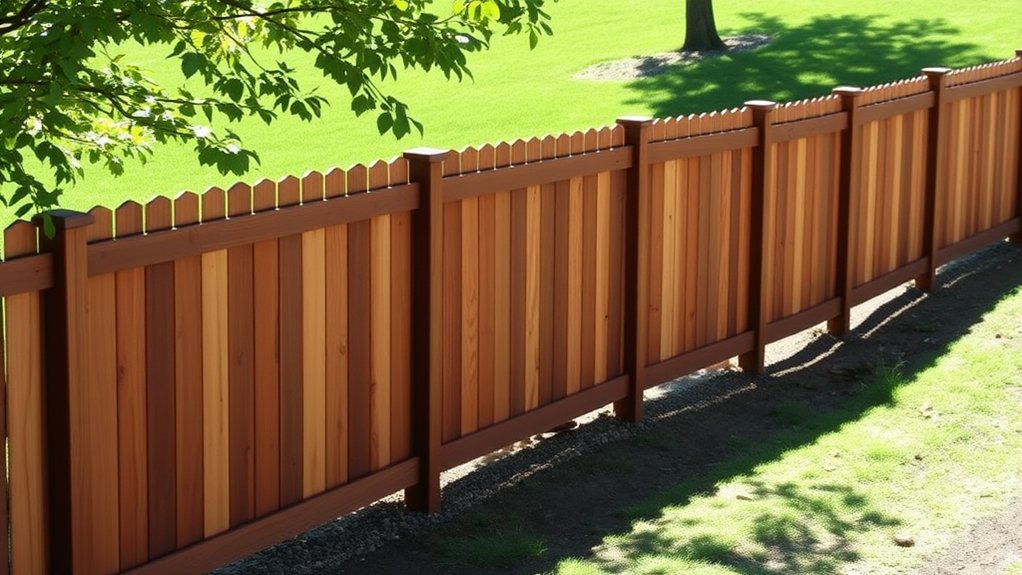
To ensure your fence remains stable and lasts on sloped terrain, follow these essential post installation practices:
- Select Heavy-Duty Anchors: Use anchors specifically made for slopes to securely hold your posts.
- Check for Plumb: Regularly verify that your posts are vertical to maintain their strength.
- Dig Deeper Holes: Ensure post holes are at least a foot deeper than the anchors to better resist erosion.
- Add Gravel Footings: Incorporating gravel helps with drainage and prevents soil erosion around the posts.
Maintenance and Upkeep Essentials
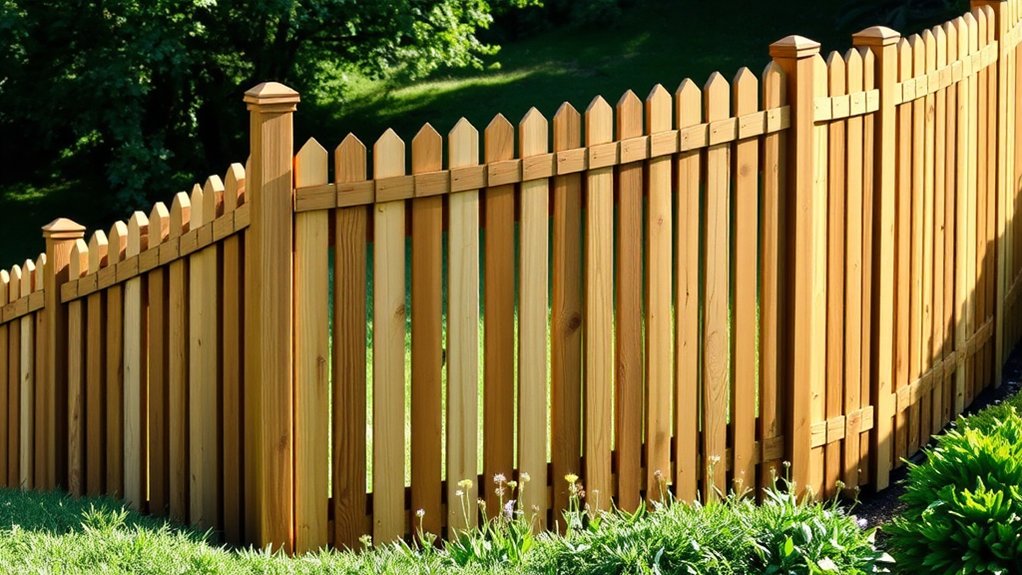
To keep your custom fence on sloped terrain in great shape, regular inspections are key.
Check the materials for wear and ensure the posts are stable, as these affect the fence’s lifespan.
Regular Inspections Importance
Regularly inspecting your fence is crucial—aim for at least twice a year. This helps catch minor issues before they become major problems.
Here are four key areas to check:
- Look for rotting wood or signs of pests that could damage your fence.
- Ensure posts are stable; loose or leaning posts may indicate soil erosion.
- Check for rusted nails or staples that can weaken your fence’s structure.
- Pay special attention to areas exposed to harsh weather or heavy stress.
By staying on top of these inspections, you protect your investment and keep your fence looking good.
Don’t wait for issues to pop up—be proactive!
Material Durability Considerations
When choosing materials for fencing on sloped terrain, focus on durability and ease of maintenance. Aluminum and vinyl are excellent options due to their long lifespan and resistance to weather damage.
Regular cleaning will keep them looking good and prevent deterioration. Using protective coatings can further extend their life against harsh conditions.
Ensure your fence design allows for proper drainage to avoid water pooling, which can cause damage. Composite materials are also effective, offering strong durability and privacy.
Post Stability Checks
Selecting durable materials for fencing on sloped terrain is crucial for longevity, but regular post stability checks are equally important.
Regular inspections help ensure your fence stays secure against soil erosion and shifting ground. Here are four essential checks to keep in mind:
- Check post alignment twice a year to spot any leaning.
- Examine the bases for looseness; erosion can occur unexpectedly.
- Test for movement by pushing on the posts; any rocking indicates a problem.
- Watch soil conditions around the posts, especially drainage, to avoid water buildup.
Enhancing Drainage Solutions

To manage water on sloped terrain and protect your fence investment, it’s essential to implement effective drainage solutions.
Start by installing channel drains at the bottom of hills to capture and redirect rainwater. Trench systems can also help collect subsurface water, preventing soil saturation around your fence posts.
Make sure to slope these systems properly to enhance drainage and reduce erosion risk by directing water away from foundations.
Retaining walls serve as vertical drains and help level the land, while dry wells can store excess water, minimizing runoff and keeping soil stable.
When to Seek Professional Help
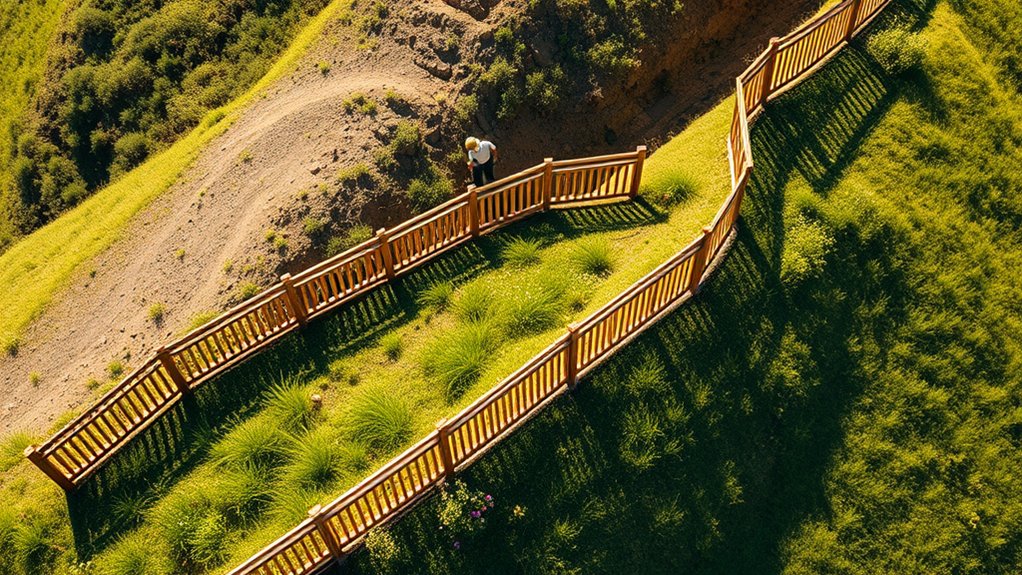
When should you call in professionals for your custom fencing project on sloped terrain? Here are four clear signs:
- Complex Terrain: If your land has steep slopes or irregular features, consulting an expert is crucial for a safe and effective design.
- Material Selection: Not sure which materials can handle stress and shifting soil? Professionals can help you choose the right options.
- Design Challenges: If you’re having trouble with stepped or contoured designs, experts ensure your fence looks good and works well with the landscape.
- Installation Needs: If the ground needs preparation or extra support, skilled installers can provide a stable and secure fence.
Getting professional help ensures your fence is durable and visually appealing.
Frequently Asked Questions
What Types of Fences Are Best for High Winds on Slopes?
For high winds on slopes, choose wind-resistant materials like galvanized steel or vinyl. Use techniques like step-down fencing and deeper posts to ensure the fence stays strong and stable in tough conditions. This helps maintain its integrity and withstands harsh weather effectively.
How Do I Prevent Pests From Damaging My Fence?
To keep pests from damaging your fence, use tight mesh materials as barriers and perform regular maintenance to fix any weaknesses. This simple strategy can significantly reduce pest problems and extend your fence’s lifespan.
Can I Paint or Stain My Fence After Installation?
Yes, you can paint or stain your fence after installation. Just make sure to allow for proper drying time. Choose colors that not only look good but also protect your fence from weather damage.
What Is the Lifespan of Different Fencing Materials?
When comparing wood and vinyl fencing, wood can last anywhere from 5 to 40 years depending on maintenance, while vinyl usually lasts 20 to 30 years. For metal options, high-quality steel can last over 50 years with proper care and installation.
How Do I Handle Fence Repairs on Steep Terrain?
To repair a fence on steep terrain, start by clearing any debris around the area. Measure the fence line carefully to ensure accuracy. Also, make sure there’s proper drainage to prevent water buildup. These steps will help enhance the fence’s stability and longevity during repairs.
Conclusion
When creating custom fencing for sloped or uneven terrain, think about how ancient builders adapted to their environments. Choose materials and designs that suit your landscape while staying within budget. This isn’t just about enclosing a space; it’s about adding character. Regular maintenance will ensure your fence lasts, and knowing when to call in experts will help your project succeed, just like the strong structures that have stood the test of time.
